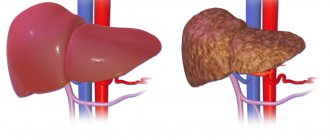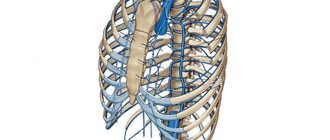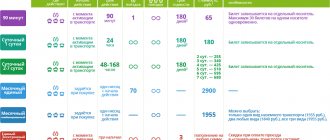Numbering of table diets
If a patient has two diseases at once and both require a table diet, the doctor prescribes a diet that will combine the principles of both diets. For example, if diabetes mellitus is combined with peptic ulcer disease, the doctor will prescribe diet 1 described below, but taking into account the exclusion of those foods that are prohibited for diabetes mellitus. All medical institutions specializing in diet tables use a number system to separate diets corresponding to the diseases that are treated with them, namely:
- Diet 1 – peptic ulcer of the duodenum and stomach;
- Diet 2 – acute and chronic gastritis, colitis, enteritis and chronic enterocolitis;
- Diet 3 – constipation;
- Diet 4 – intestinal diseases accompanied by constipation;
- Diet 5 – diseases of the biliary tract and liver;
- Diet 6 – urolithiasis and gout;
- Diet 7 – chronic and acute pyelonephritis, nephritis and glomerulonephritis;
- Diet 8 – obesity;
- Diet 9 – diabetes mellitus;
- Diet 10 – diseases of the cardiovascular system;
- Diet 11 – tuberculosis;
- Diet 12 – functional diseases of the central nervous system;
- Diet 13 – acute infectious diseases;
- Diet 14 – kidney stones;
- Diet 15 – diseases that do not require special diets.
General information
If a person is sick, then, in most cases, he “bet” on drug treatment. However, the correct approach to treating any ailment should be based on an integrated approach. That is, in the treatment process, the medication regimen, the patient’s lifestyle, and, without a doubt, his diet are important. The Pevzner diet involves proper organization of nutrition during the treatment of various diseases. This nutritional system not only promotes healing, but also helps prevent relapses and avoid exacerbations. The article below will discuss the nutritional system developed by nutritionist Mikhail Pevzner and which helps modern doctors successfully heal various diseases.
Medical diet 1
This diet is followed from six months to a year; it is allowed to eat pureed vegetable, milk and cereal soups and boiled chopped vegetables (in the form of purees or steam puddings). Also allowed on this diet table are pureed milk porridge with butter, boiled lean meat and lean fish, non-acidic dairy products, steam omelettes and boiled eggs (soft-boiled), crackers and stale white bread, jam, sweet berries and fruits. During this diet, you are allowed to drink freshly squeezed berry, vegetable and fruit juices and compotes, rosehip infusion and various jelly, tea, cocoa and milk.
Essence and basic principles
The author of this system is nutritionist M.I. Pevzner. Diets were developed to organize proper nutrition and speedy recovery of patients suffering from various diseases.
Each of them is called a “table” with an assigned number (from 1 to 15). Some diets have several variations, indicated by letters. There is also a zero table designed for the restoration of the gastrointestinal tract after surgical interventions.
The basic principle of all diets is that to determine the required amount of food, calorie counts are used (unit of measurement - kcal). This is due to the fact that many diseases cause weakness and a feeling of loss of strength, and to eliminate such ailments, the body must receive enough energy (through proper nutrition).
All menus contain foods that modern nutritionists consider harmful and recommend limiting or eliminating (white bread, refined rice, and so on). This is explained by the fact that coarse fibers from unprocessed products can injure the gastrointestinal tract in the presence of a number of diseases.
Diets do not differentiate between healthy and unhealthy foods. The selection of products is carried out based on the body's needs for calories and nutritional compounds, as well as the specifics of diseases (and conditions caused by them).
Pevzner's diets do not involve serious restriction of carbohydrates (compared to many modern nutrition systems). Even table No. 9, designed for patients with diabetes, includes cereals and flour products in the menu in significant quantities (however, all permitted products have a low GI index).
Medical diet 2
The menu for this diet table is as follows:
- Puréed vegetable soups with cereals based on meat, mushroom or fish broth;
- Lean meat, boiled chicken, steamed or fried cutlets, lean ham, boiled lean fish and black caviar;
- Omelette and soft-boiled eggs;
- Boiled and raw vegetables and fruits;
- Stale bread, white and gray;
- Mashed porridge;
- Tea, coffee and cocoa;
- Flour dishes (except baked goods);
- Milk, butter, cream, kefir, non-acidic sour cream, yogurt, non-acidic cottage cheese and mild cheese;
- Fruit and vegetable juices;
- Marmalade and sugar.
Main menu
All 15 diets have significant differences from each other. They must be used strictly according to recommendations, and not in random order. For example, table No. 5 is designed for nutrition for pancreatitis, and its menu is based on minimizing fat.
Table No. 7 is intended for people suffering from kidney diseases, and it is based on a strong restriction of protein foods. This means that all requirements and recommendations were compiled on an individual basis, taking into account available scientific data and observational results.
Table No. 1
Tables according to Pevzner, the table of which contains a complete description, begin with diet No. 1 - the most strict and restrictive. Its requirements are aimed at eliminating inflammatory processes, normalizing the secretory function of the stomach and its motility, accelerating the healing process of ulcers.
Since the diet involves the use of foods that do not irritate the gastric mucosa, purees will most often be found in its menu. Sometimes ordinary dishes are allowed, but they must be prepared exclusively from soft ingredients. The menu offers 5 meals, in addition to which you should drink a glass of warm milk before bed.
| Day | breakfast | snack | dinner | snack | dinner |
| 1 | steam omelette with low-fat milk with oatmeal, seasoned with 1 tsp butter, tea (weak) | baked apples with honey | soup with potatoes, zucchini and cauliflower potatoes and zucchini with stewed perch cutlets plum and raisin compote | 1 tbsp. warm milk | pasta, ravioli with fish |
| 2 | boiled egg (not hard-boiled) and pureed rice porridge with milk, chicory coffee | chopped pears and mango | puree soup with oatmeal and thick cream, seasoned with egg, mashed potatoes and baked turkey fillet, dried fruit compote | mixed fruit mousse | pasta with cottage cheese, seasoned with oil, steamed fish fillet with egg |
| 3 | banana and cottage cheese puree, beet salad with butter, a slice of wheat cracker with butter, green tea | mashed bananas with rosehip syrup | soup with oatmeal, potatoes and cream, wheat porridge with butter, boiled chicken, raspberry jelly | freshly squeezed grape-apple juice | pureed beetroot and carrot stew (minced vegetables) |
| 4 | buckwheat porridge without additives, omelette made from only proteins, chicory coffee with milk | thick jelly made from milk | carrot and pumpkin paste in broth with wheat bread toast, rice porridge, steamed veal cutlets | cookies and tea | mashed potatoes with pieces of meat |
| 5 | mashed potatoes and carrots, steamed milk-based omelette, chamomile tea with natural honey | cottage cheese with raspberries, pureed and sweetened | soup with crushed buckwheat, carrots, buckwheat porridge, seasoned with butter, and baked pork fillet with carrots, lemon balm tea, sweetened with honey | blueberry curd cream | chicken zrazy with buckwheat porridge |
| 6 | undercooked semolina porridge and tea with milk | cookies and jelly | soup with meat broth, stewed rabbit, side dish of vegetables, compote | berry mousse | mashed potatoes, steamed chicken, herbal tea; |
| 7 | 2 soft-boiled eggs, cottage cheese casserole, tea | bun and juice | soup with dumplings, meat boiled and baked in the oven with bechamel sauce, jelly | baked apples | boiled fish, baked potatoes, tea with milk |
Table No. 2
Pevzner tables, the table of which describes each nutrition plan, have a direct impact on the causes of the disease and increase the effectiveness of treatment. For example, the effect of diet No. 2 on the stomach is to protect it from mechanical irritation and eliminate additional stress on the mucous membrane.
This effect is achieved through the consumption of certain foods that are absorbed very quickly without remaining in the stomach. Products for this table are boiled, stewed or baked, the meat is minced in a meat grinder or finely chopped. Modest portions of food are evenly distributed over 5 meals a day.
| day | breakfast | snack | dinner | snack | dinner |
| 1 | creamy pudding, soft-boiled egg, tea | marmalade | noodles in meat broth, steamed lean meat, carrot puree, berry compote | tea with cookies | buckwheat pudding with grated baked cheese, jelly |
| 2 | pureed oatmeal with milk, soft-boiled egg, tea | grated processed cheese, compote | soup with meatballs in meat broth, stewed meat and vegetables, compote | jelly, cookies | jellied fish, rice puree, with sweet sauce, tea |
| 3 | curd pudding, buckwheat milk | marshmallows, jelly | cauliflower and carrot puree, stewed minced meat and potatoes, compote | apple juice diluted with water, cookies | boiled rice, fish stewed in cream, tea |
| 4 | egg, oat milk, tea | baked apple | vegetable soup with meat broth, boiled stroganoff, noodles, compote | jelly, cookies | boiled dumplings, mashed potatoes; compote |
| 5 | steamed omelette with cheese, green tea | processed cheese with milk | vermicelli in broth, steamed cutlets, mashed potatoes, apple sauce | marmalade | boiled cauliflower, buckwheat baked in cream, rose infusion |
| 6 | grainy cottage cheese, soft-boiled egg, tea | blueberry jelly | rice soup with meat broth, potato casserole with boiled minced meat, dried fruit compote | cookies, rosehip decoction | fish cutlets, pumpkin casserole, jelly |
| 7 | pureed rice porridge, tea | pureed cottage cheese with milk, compote | potato casserole with meat, borscht with meatballs, compote | baked apple | Boiled beef; pureed buckwheat, green tea |
Table No. 3
Treatment table No. 3 according to Pevzner is prescribed for long-term problems with the functioning of the large and small intestine, which are characterized by delayed bowel movement.
| day | breakfast | snack | dinner | snack | dinner |
| 1 | tea with honey, pureed buckwheat porridge | whipped cream and cottage cheese | prune compote, borscht, meat chop; | glass of kefir | mashed potatoes with vinaigrette, milk |
| 2 | wheat porridge with dried fruits, fresh vegetable salad with kefir | puree of plum and apple pulp | shrimp soup, carrot juice, tuna fillet and vegetable salad | plum jam, unsweetened tea, crackers | fish cutlets with buckwheat, fermented baked milk |
| 3 | cabbage salad, tomato omelette, pear compote | herbal drink with honey | beet salad, light chicken soup, tomato juice | carrot and cabbage salad | baked goods with prunes, cabbage rolls stuffed with chicken (without rice), compote |
| 4 | Yachka porridge, carrot-pear juice, cheese | carrot salad with sour cream dressing | beetroot salad with nuts, vegetable soup, steamed fish | low fat yogurt | milk, lean vegetable puree, bread |
| 5 | crumbly buckwheat porridge, kefir, raw carrot salad | pineapple pulp (raw) | vegetable lean soup, baked goat meat with potatoes, orange drink | apple, yogurt | pumpkin appetizer, eggs, rosehip |
| 6 | buckwheat porridge with fresh cucumbers, curdled milk | cottage cheese-peach dessert | potato soup, crispy salad of raw vegetables (cucumbers, tomatoes), boiled chicken breast | fruit puree | milk tea, baked pumpkin, sweetened with honey |
| 7 | fruits, zucchini casserole, bread with kefir | cabbage salad with pumpkin pulp | pollock with cheese sauce, baked vegetables, lean soup, milk | fruits or berries (0.5 tbsp.) | berry jelly |
Table No. 4
During the treatment of colitis, it is important to follow a diet to alleviate the symptoms of the disease and improve the functioning of the digestive tract. Table No. 4 is designed precisely for this purpose. The diet has several subtypes, designed for different severity of colitis. In any case, this table requires eating soft food in a warm state, and also drinking at least 1.5-2 liters of water per day.
| Day | breakfast | snack | dinner | snack | dinner |
| 1 | buckwheat | baked pumpkin with dried apricots | buckwheat soup with minced meat | dried blueberry decoction | cottage cheese and fruit pudding |
| 2 | oatmeal, stale white bread with sharp cheese | carrot and cauliflower puree | stewed rabbit, jelly | semolina porridge, berry jelly | stewed sea bass with zucchini and carrots |
| 3 | steam omelette made only from egg whites | 100 g fruit | boiled chicken with broth, fresh tomato | rosehip decoction | boiled tongue with stewed carrots |
| 4 | cheesecakes with low-fat sour cream | cheesecake, jelly | chicken soup with rolled oats | cookies and tea | pasta with cottage cheese and raisins |
| 5 | rice porridge and low-fat sausages | beetroot and carrot puree | noodle soup with beef and dill | a few crackers with a slice of orange | stewed carrots with cream |
| 6 | semolina | dessert pilaf with fruits | soup with pasta and egg | waffle and unsweetened tea | curd mass from low-fat cottage cheese |
| 7 | rice porridge, apples, tea | pie with apple jam, dried fruit compote | creamy soup with rice cereal | blueberry jelly, cottage cheese | thick jelly |
Table No. 5
If there are problems with the functioning of the liver and gallbladder, diet No. 5 is prescribed. For her diet, food is prepared by boiling and baking; frying is prohibited. You need to eat 4 times a day, plus drink a glass of kefir at night.
| day | breakfast | snack | dinner | snack | dinner |
| 1 | steamed egg white omelette | apple jelly | broccoli and potato soup, biscuits | pureed cottage cheese with paprika | vegetable stew |
| 2 | rice porridge with plums | mixed fruit smoothie | vegetable soup, a slice of rye bread | Ryazhenka with jam | steamed chicken drumsticks, carrot salad |
| 3 | oat flake porridge with apple pulp | pumpkin puree | pasta soup, slice of toasted bread | crackers and kefir | buckwheat porridge, beet salad |
| 4 | egg white omelette with vegetables | milk, cookies | diet with beets No. 5 | cheese with pear jelly | bulgur with cauliflower |
| 5 | pumpkin rice porridge | apples baked with cottage cheese | pumpkin soup and biscuits | compote and crackers | zucchini casserole with rice |
| 6 | egg white omelette with cheese | dumplings with cherries and tea | soup with potatoes and rice | croutons, compote | fish soufflé, buckwheat |
| 7 | noodle soup | apple jelly | buckwheat-vegetable soup, a piece of bread with bran | macaroni and cheese casserole | potato salad with avocado and chicken |
Table No. 6
Tables according to Pevzner (the table and descriptions for which are usually presented in detail) also include a hypouricemic diet prescribed for gout. Its principle of action is based on the exclusion from the diet of foods with large amounts of purines and oxalic acid.
| day | breakfast | snack | dinner | snack | dinner |
| 1 | raw carrots, cabbage-cucumber salad, bran bread and rosehip decoction | potato decoction, carrot-pumpkin salad, eggs, | milk soup, potato and zucchini stew, compote | fresh cottage cheese with pieces of fruit | stewed white cabbage, milk |
| 2 | cheesecakes, marmalade, kefir | oat flakes and milk | squash soup, boiled fish, mashed potatoes | fruit and milk smoothie | egg and carrot salad with croutons, corn grits porridge, and fermented baked milk |
| 3 | cottage cheese casserole, carrot-apple juice | yogurt with cereal flakes | vegetable lean soup, cabbage salad, natural tomato juice | marmalade, fruit | oatmeal, stewed vegetables, tea |
| 4 | carrot stew with curd dressing, oat flakes with apple pulp, compote | soup with milk | buckwheat porridge, beef cutlets, cabbage solyanka, juice | any berries or fruits | pasta, beet salad with rapeseed oil, jelly |
| 5 | sweetened rice porridge with apple pulp, juice | fruits | lean borscht, carrot cutlets, milk | kefir, fruit | boiled rice with pieces of pepper, pancakes with fruit topping, compote |
| 6 | lean okroshka, compote | fruits with liquid cream | kefir with boiled mixed vegetables | apple-carrot juice | fresh vegetable salad, boiled chicken breast, berry juice |
| 7 | milk, buckwheat porridge, toast with jam or butter | marshmallow or fruit marmalade, tea | soup with potatoes and pearl barley, pancakes, compote | fresh berries and fruit juice | banana cheesecakes, bran broth |
Table No. 7
Like other treatment tables, diet No. 7 in its general version is suitable for chronic kidney disease or at the recovery stage.
| day | breakfast | snack | dinner | snack | dinner |
| 1 | egg, homemade cheese with sour cream, light tea | baked apple | vegetable lean soup, potato casserole with meat, compote | warm rosehip decoction with croutons | pilaf, fresh vegetable salad, tea |
| 2 | buckwheat, dried fruits, tea | baked pumpkin, barley drink | rice and vegetable soup, meatballs, jelly, compote | kefir | fish, mashed potatoes, salad, tea |
| 3 | egg, carrot cutlets with sour cream, tea | cottage cheese, sour cream | beets, vegetable stew with turkey, jelly | bulgur with breadcrumbs | rice, fish, salad, tea |
| 4 | steam omelette, fresh vegetable salad, tea | apple pudding | fish soup, potatoes with veal, compote | baked fruits, kefir | pasta with sour cream sauce, salad, rosehip broth |
| 5 | oatmeal porridge, natural cottage cheese with sour cream dressing, tea | apple slices | lean vegetable puree soup, stewed rabbit meat, mashed potatoes, compote | biscuits and tea | potato-carrot casserole, croutons, rosehip tea |
| 6 | sweet pilaf, carrot cutlets, tea | cottage cheese soufflé | soup with vegetables and pearl barley, buckwheat with boiled chicken, salad, compote | fruit pudding | corn grits porridge, potato cutlets with sour cream, rosehip tea |
| 7 | millet porridge seasoned with dried fruits, egg, tea | beet salad | lean vegetable soup with pasta, mashed potatoes, steam cutlets, salad, compote | curdled milk | curd-buckwheat krupenik, rosehip tea |
Table No. 8
Diet No. 8 is designed to lose weight without harm to the body. However, it should be borne in mind that it can be followed only in the absence of problems with the gastrointestinal tract.
| day | breakfast | snack | dinner | dinner | before bedtime |
| 1 | vegetable salad with meat, coffee with milk | soft cheese | lean vegetable soup, boiled meat with stewed cabbage, unsweetened apple compote | vinaigrette with boiled meat, coffee with milk | 1 tbsp. kefir |
| 2 | marinated fish with boiled potatoes, rosehip broth | soft cheese | okroshka, boiled meat with beetroot stew, unsweetened compote | lean vegetable cabbage rolls, rosehip infusion | 1 tbsp. yogurt |
| 3 | 2 fried eggs, lean vegetable salad, coffee with milk | cottage cheese with milk | beetroot soup, stewed meat, mixed vegetables, tomato juice | cabbage stew, boiled fish, rosehip broth | 1 tbsp. kefir |
| 4 | boiled tongue and raw cucumber, beet puree, coffee with milk | soft cheese | lean soup from frozen vegetables, boiled chicken with white sauce and carrot puree, marmalade | cabbage stew, fish, rosehip broth | 1 tbsp. yogurt |
| 5 | herring with boiled potatoes, coffee with milk | soft cheese | lean borscht, boiled beef stroganoff with beetroot stew, unsweetened jelly | zucchini puree with omelette, rosehip broth | 1 tbsp. kefir |
| 6 | light ham, cucumber salad with butter dressing, coffee with milk | butter curd cheese | cabbage soup with egg dressing, green peas with stewed meat, apple dessert | fish with cabbage stew, rosehip broth | 1 tbsp. kefir |
| 7 | vegetable stew with beef, coffee with milk | soft cheese | mushroom borscht, cutlet with stewed carrots, marmalade | cottage cheese casserole with carrots, rosehip broth | 1 tbsp. kefir |
Table No. 9
Table No. 9 is considered gentle and suggests eating small portions 5-6 times a day.
| day | breakfast | snack | dinner | snack | dinner |
| 1 | egg white omelette with pieces of vegetables, tea with milk | grated carrots | cabbage soup, steamed pearl barley porridge | cottage cheese casserole | dumplings with sour cream dressing, tea with milk |
| 2 | brewed bran with apple slices and raisins, weak coffee with milk | 0.5 tbsp. red berries | broccoli soup with cheese broth | boiled shrimp, cucumber slices | stuffed peppers, blueberry juice |
| 3 | cottage cheese and blueberries, sour cream pudding, chamomile tea | plums or nectarines (2 pcs.) | okroshka with chicken, cabbage stew | asparagus, vegetable stew | stewed chicken with raw vegetable salad |
| 4 | apple cheese casserole, unsweetened tea | baked pear with cottage cheese | vegetable lean soup, fish cutlets with cream sauce | cottage cheese casserole with carrots | vegetable stew with chicken fillet, cocoa |
| 5 | 2 eggs with soft yolk, a slice of cheese with bread, compote | strawberry juice jelly | beetroot soup with veal | apple juice and vegetable salad | baked sea bass, fried tomatoes and zucchini on |
| 6 | boiled bran, 2 eggs with soft yolk, unsweetened chicory | 2 oranges | meatball soup, lean vegetable goulash | stewed carrots with cream, rosehip broth | boiled hake, raw vegetable salad |
| 7 | bran porridge with juicy berries, not strong coffee | large unsweetened apple | lean soup, boiled tongue with light sauce | natural berry mixture with low-fat yogurt | boiled pollock with raw vegetables |
Table No. 10
Diet No. 10 is very varied and its restrictions are not too great. The basic principle of this nutritional system prescribed for cardiovascular diseases is to reduce the amount of salt in the menu and increase potassium intake.
| day | breakfast | snack | dinner | snack | dinner |
| 1 | boiled eggs, oat drink, tea | baked apples | lean vegetable soup with barley, boiled chicken fillet with vegetables, compote | rosehip decoction | mashed potatoes, boiled fish kefir |
| 2 | mixture of fruits and cottage cheese, tea | yogurt | lean borscht, baked potato, beef stroganoff | marmalade | pilaf with meat, vegetable stew, compote |
| 3 | soup with milk, tea similar | mousse | beet soup, fish cutlets, vegetables | marmalade | buckwheat, boiled veal, vegetable stew, tea |
| 4 | carrot puree with cottage cheese, fresh | fruits | pasta in tomato sauce with chicken, compote | kefir | yachka porridge, beef, stewed vegetable salad with oil dressing, jelly |
| 5 | pilaf with added fruit, juice | fruits | lean borscht, chicken-carrot cutlets, milk | jelly | mashed potatoes, boiled fish with vegetables, compote |
| 6 | milk soup, juice or compote | fruit and curd dessert | chicken zrazy with cheese, boiled vegetables, compote | Fresh Juice | vinaigrette, pearl barley porridge, vegetable vegetarian stew |
| 7 | steamer omelette, milk tea | marmalade | soup with potatoes and buckwheat, chicken fillet with vegetables, compote | rosehip decoction | mashed potatoes with vegetables, compote |
Table No. 11
The table of tables according to Pevzner also contains a very unusual diet No. 11. This nutritional system is prescribed for long-term illnesses that can cause depletion of the body (most often tuberculosis or prolonged pneumonia).
| day | breakfast | snack | dinner | snack | dinner |
| 1 | buckwheat milk porridge, sweetened with honey, with the addition of dried apricots and nuts | dried fruit compote and cheese slices | borscht, mashed potatoes with chicken, raw vegetable salad | kefir and cake | baked mackerel and vegetables |
| 2 | scrambled eggs with cheese and natural sausage | juice and cheesecake | chicken soup, beef pilaf, vinaigrette | crackers and cocoa | steamed eggplants with meat |
| 3 | omelet, fresh cabbage salad with apples, pancakes | slice of toast and tea | pickle, buckwheat with meat, mixture of stewed vegetables | cream cheese | mixed vegetable stew, fish stew |
| 4 | oat flakes sweetened with honey, with fruit pancakes with jam | hard-boiled egg | Solyanka, baked potatoes with lean pork, fresh peppers, cucumbers and tomatoes | juicy fruits and nuts | boiled chicken and squash caviar |
| 5 | beef in cream, apple pie, fresh pear or orange | cheese | meatball soup, mashed potatoes with baked fish | oat flakes with kefir | French meat, baked apples |
| 6 | noodle soup, compote with dried fruits | soft cheese | puree soup with meat broth, pork tenderloin and buckwheat | fruits | grilled vegetables with fish |
| 7 | classic cottage cheese casserole, tea with a slice of lemon | blueberry pudding | okroshka, pasta with vegetables and chicken | cheese | zrazy with cheese fresh vegetable salad |
Table No. 12
Diet No. 12 is usually defined as part of a complex treatment of dysfunctions of higher nervous activity. Its goal is to reduce the load on the nervous system, including due to inappropriate food. Sources of caffeine and alcohol, as well as sweets, are excluded from the menu, and foods with a high content of minerals and vitamins are added.
| day | breakfast | snack | dinner | snack | dinner |
| 1 | oat flakes with milk, green tea | Big apple | lentil soup with vegetables, beef goulash with sauce | orange juice jelly | liver cake, glass of kefir |
| 2 | oatmeal with apple, a glass of milk; | baked pears, fruit juice | cabbage soup and carrots stewed in cream | marshmallows, rosehip decoction | boiled potatoes with pickled herring |
| 3 | sandwiches made from bran bread, with unsalted cheese and low-fat ham; | fruit salad with yogurt dressing | pea soup, pearl barley porridge with chicken | marshmallows with herbal tea | vinaigrette, rice cereal, 1 tbsp. kefir or fermented baked milk |
| 4 | millet porridge in milk with dried apricots and plums, green tea | mint tea cookies | fish soup with croutons, bean puree with slices of ham | rice pudding with cherry juice | baked beef with potatoes, jelly |
| 5 | egg white omelette with tomatoes and chicken pieces, a glass of fermented baked milk | baked pumpkin | borscht with beans, boiled beetroot and carrot salad | vegetable salad with sour cream | cabbage rolls with minced beef, herbal tea |
| 6 | cottage cheese with apples and cinnamon | bread with eggplant caviar | okroshka, buckwheat with chickpeas | peach mousse | boiled hake with vegetables |
| 7 | Lazy dumplings seasoned with sour cream | puree of mixed vegetables stewed | beet soup, zucchini stewed with minced beef | fruit marmalade with herbal (chamomile) tea | stewed beans with plums, tea with lemon balm |
Table No. 13
Diet 13 is a therapeutic diet plan for exacerbation of diseases caused by infectious contamination.
| day | breakfast | snack | dinner | dinner | before bedtime |
| 1 | buckwheat porridge with meatballs, tea | dessert carrot mousse | veal cream soup with cauliflower, biscuits, fruit juice | warmed squash caviar | 1 tbsp. acidophilus |
| 2 | semolina porridge with milk, tea | baked apples | soup with carrots, potatoes and hot peppers, lingonberry compote, a portion of biscuit | potato casserole, chamomile tea | 1 tbsp. compote or juice |
| 3 | classic cottage cheese casserole, tea with milk | berry jelly | fish soup with fresh herbs, fruit jelly | buckwheat with low-fat minced meat | 1 tbsp. kefir |
| 4 | liquid rice porridge, tea, cookies | quince marmalade | Lenten cauliflower soup with tomato, compote, biscuits | fish cakes, stewed pumpkin | linden flower tea |
| 5 | stewed carrots, tea | 1 tbsp. kefir | lean soup with buckwheat, sour cream and croutons, plum compote | pasta with low-fat fish | chamomile decoction |
| 6 | semolina porridge with milk, tea | fruit juice jelly | creamy rice soup, tomato juice | meatballs with vegetables and cream sauce | 1 tbsp. yogurt |
| 7 | carrot pudding, green tea | rosehip decoction | beet puree, biscuits, cranberry mousse | chicken pudding, boiled potatoes | 1 tbsp. lime tea |
Table No. 14
Table No. 14 is used for phosphating, which is a type of urolithiasis (a disorder of the metabolism of phosphorus and calcium in the body). Therefore, the purpose of this diet is to normalize chemical processes, as a result of which the intake of foods with a high calcium content, as well as with alkaline properties, is sharply limited in the diet.
| day | breakfast | dinner | snack | dinner |
| 1 | green tea, rice porridge, honey, bread; | apple juice, noodle chicken soup, baked chicken leg | jelly and rye crackers | pea and minced meat salad, bread with liver pate, herbal tea |
| 2 | pureed buckwheat porridge, pomegranate drink; | rhubarb tea, shrimp soup, baked chicken cutlets and rice | viburnum stewed with sugar | honey-herbal drink, pumpkin porridge |
| 3 | blueberry compote, pearl barley with meat; | Sea buckthorn fruit drink, beef soup with rice, pumpkin pudding | pumpkin puree | grilled meat, boiled noodles and tea |
| 4 | blueberry compote, slimy oatmeal, egg white; | mushroom noodle soup, buckwheat and meatballs, apple compote | blueberry jam on a slice of bran bread | beef soufflé, boiled rice, gooseberry broth |
| 5 | tea with lemon, oatmeal with pumpkin and honey | baked chicken breast, half a glass of noodles, rice soup, sea buckthorn juice | apple ice cream | apple-pumpkin casserole, blueberry jelly |
| 6 | boiled squid, pearl barley porridge, rosehip tea | fish soup, pork chop, apple-lemon juice | berry jelly | salad with pieces of meat and peas with sour cream, apple and gooseberry drink |
| 7 | herring, boiled noodles, green tea | boiled mushrooms with buckwheat, oatmeal soup, pomegranate juice | berry puree | rhubarb soup with honey, pumpkin rice jelly |
Table No. 15
Table No. 15 is suitable for those who are in an intermediate period to a normal diet, and actively restores the strength and energy spent fighting the disease. The diet is prescribed only if the recovering patient does not have problems with the gastrointestinal tract.
| Day | breakfast | snack | dinner | snack | dinner |
| 1 | oatmeal with butter, toast with cheese, tea | fresh fruit and natural yogurt | raw vegetable salad, chicken soup, veal with stewed vegetables | banana cake, 1 tbsp. compote | fish with vegetables, baked, lettuce |
| 2 | milk porridge from oat flakes, biscuits with tea | fruit slice salad | veal soup, chicken and cabbage stew, tea | raw vegetable salad | pasta with cheese |
| 3 | milk porridge from rice cereal, seasoned with butter, coffee with milk | fruit slices with soft cheese | lean soup with rice, chicken and mixed vegetables stewed | jelly | chefir pasta with meat |
| 4 | oatmeal milk porridge, coffee with lime | vegetable salad with a slice of sausage | borscht, baked cutlet with vegetables | soft cheese | baked fish and mashed potatoes, tomatoes |
| 5 | semolina porridge, cheese, tea | fruit slice salad | raw vegetable salad, bean soup, mashed potatoes with sausages | fruits and kefir | pearl barley porridge and stew |
| 6 | buckwheat porridge, cheese, coffee | oranges | jellied soup, stewed meat with vegetables, jelly | fruit cake and tea | pasta with stewed meat |
| 7 | vermicelli with milk, coffee | pumpkin pie | pickle, jelly, chicken pilaf | kefir | carrot-beet salad, baked fish, tea |
Reviews of table No. 15 according to the Pevzner system indicate that this diet helps to smoothly transition from therapeutic nutrition with multiple prohibitions and restrictions to a normal diet.
However, some continue to comply with the requirements of this system permanently. Since diet No. 15 is the mildest in the table and allows you to consume almost any food, it can be used as a basis for organizing proper nutrition.
Medical diet 4
The menu for this medical diet is as follows:
- Strong tea, cocoa and strong coffee;
- Fresh mashed cottage cheese;
- One soft-boiled egg per day;
- Slimy soups on water;
- A decoction of dried black currants and blueberries;
- Stale white crackers;
- Low-fat three-day kefir;
- Puree rice and semolina porridge in water;
- Boiled meat and fish;
- Steam cutlets in minced form with the addition of rice instead of bread to the minced meat;
- Blueberry jelly and jelly.
Who is Pevzner?
Mikhail Pevzner is a general practitioner who can rightfully be called one of the founders of dietetics. He was also one of the organizers of the Moscow Institute of Nutrition, and a professor at the Central Institute for Advanced Medical Studies. Pevzner conducted numerous studies on the influence of nutrition on the mechanisms of development of various diseases of organs and systems. His contribution to the study of the effect of diet therapy on the human body is currently assessed as very significant.
He developed his nutritional method in 1929. Later he became the initiator of introducing so-called medical tables in sanatoriums and resorts of the USSR.
According to Pevzner, there are dietary tables 1-15, each of which provides different nutritional systems. Therapeutic diets according to Pevzner have been successfully used as an important element in the complex treatment of patients with a variety of ailments.
Medical diet 5
The menu for this medical diet is as follows:
- Vegetarian fruit and dairy, cereal soups with vegetable broth;
- Milk, kefir, fresh yogurt, cottage cheese up to 200 g per day and acidophilus milk;
- Boiled meat, poultry and lean fish;
- Ripe fruits and berries, raw, baked and boiled;
- Porridges and flour dishes;
- Vegetables and greens;
- Vegetable and fruit juices;
- Honey;
- One egg a day;
- 70 g sugar per day;
- Jam;
- Tea with milk.
Nutrition according to Pevzner in modern medicine
The above characteristics of the main therapeutic diets indicate that all of their types are successfully used for various diseases. However, in medical inpatient institutions a new nomenclature of dietary tables is currently in effect.
Although in general the characteristics of medical nutrition diets in medical institutions indicate that they are based on the works of Pevzner. The current classification of therapeutic diets is not so broad. The main options used in nutritional therapy are as follows:
- Main table - it replaces a row of Pevzner tables.
- Diet with mechanical and chemical sparing.
- High protein diet.
- Diet with a reduced amount of protein.
- Low calorie diet.
These diets use medicinal recipes from Pevzner tables.
Medical diet 8
The main objective of this diet table is to reduce the consumption of carbohydrates and fats; the recommended diet includes the following foods and dishes:
- 100-150 g of rye, protein-wheat and protein-bran bread;
- Dairy products;
- Vegetable soups, okroshka, cabbage soup, beetroot soup and borscht;
- Lean varieties of meat, poultry and fish;
- Seafood;
- Vegetables and fruits.
Exceptions to this table diet are products made from wheat flour and pastry, potatoes, cheeses, beans, pasta, fatty meats, cream, sausages, smoked meats, canned food, fatty cottage cheese, rice, semolina and oatmeal, sweet berries, sweets, honey, juices, cocoa, fatty and spicy snacks, sauces, mayonnaise, herbs and spices.
Functions
A properly prescribed therapeutic diet performs the following functions:
- is part of the main therapeutic course;
- replaces other medications that have proven ineffective in treating the disease;
- creates a favorable background for greater effectiveness of other prescribed therapeutic agents;
- improves the patient's condition;
- promotes his speedy recovery;
- is the basis of spa treatment;
- serves as a preventive measure;
- delays the exacerbation of chronic diseases;
- prevents relapses;
- consolidates the positive result of the treatment course.
Today, doctors consider therapeutic diets an obligatory part of the treatment of absolutely any disease, from a harmless acute respiratory viral infection to serious systemic disorders of the body.
Meal routine
Fat cheese, white bread and even sweet fruits are prohibited
You need to eat 5-6 times a day, it is best to eat every 3 hours, so as not to have time to get hungry. Portions should be small.
If the volume is not enough to feel full, you can fill the volume with green salads and raw vegetables.
At night, a glass of kefir or milk is required, perhaps with a small portion of bran or natural fiber, so as not to feel hungry before bed.
For a healthy person who wants to adjust their weight by only a few kilograms, the 8th table may seem overly tough, because the list of forbidden foods is very long.











